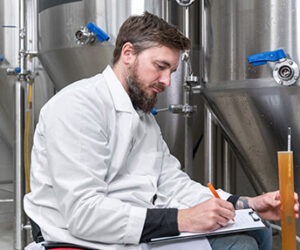Enjoy the Freedom of Homebrewing

As I transition from brewing 10-gallon (37.9-L) batches in my garage to 10-barrel (BBL) (11.7-hL) batches at Sapwood Cellars in Columbia, Maryland, I’m savoring the freedoms of homebrewing. My brewing partner, Scott Janish, and I will be “professional homebrewers” as much as we are able. While we can adapt our overall approach and many recipes and processes to commercial production, we must abide by regulations and have an eye toward economics. If you’re a homebrewer, you can embrace ingredients and techniques which commercial breweries simply cannot in many instances. But if you’re planning a brewery, you might adapt to those restrictions placed on breweries in preparation of the opening.
Government Regulations
Each country regulates alcohol differently. In the United States the Tax and Trade Bureau (TTB) and Internal Revenue Code (IRC) have separate sets of definitions and requirements for distilled spirits, wine, and beer. These differences in approach were not an issue when there was little crossover, but creative brewers have pushed into new territory blurring the lines between these mutually-exclusive categories. As far as the US government is concerned, craft brewers can add wine grapes to beer and age their brew in a wine barrel, but pouring a case of Merlot into a stout is unacceptable. Distilled alcohol may only be added to beer in the form of vanilla extract or as other “nonbeverage ingredients,” not as Bourbon or other alcoholic beverages. As a homebrewer, it is easy and economical to blend a bottle of Gewürztraminer into a keg of funky saison rather than sourcing grapes, or add a few ounces of Scotch to a wee heavy rather than age it in a Scotch barrel.
The TTB imposes minimum requirements on the classic brewing ingredients. Alcoholic beverages that don’t fit into one of the TTB’s categories fall under the auspices of the Food and Drug Administration (FDA), not a good place to be. . . Beer must be primarily fermented from grain, so no braggots with 60% honey or sour beers with 50% cherries. Black Project in Denver, Colorado walks right up to this line with their Mach-Limit series, sour beers made with 49% wine grapes. The TTB also requires 7.5 lbs. (3.4 kg) of hops, or an equivalent amount of extract, per 100 BBLs (117 hL) which equates to 0.19 oz. per 5 gallons (5.4 g per 18.9 L). That requirement isn’t onerous considering some breweries dry hop with that much per barrel, but it still results in gruits and ancient recreations with inauthentic doses of hops. A homebrewer (but not a commercial brewery) might eschew the traditional 3-5 IBUs in a Berliner weisse because it may be enough to inhibit Lactobacillus (the lower the pH, the more inhibitory hop compounds are on Lactobacillus activity). In a few cases the TTB and IRC requirements are oddly out of step, leading the TTB to treat sake as wine (as it has no hops), while the IRC taxes sake as beer.
The TTB requires formula review for beers containing any ingredient not on their list of 89 Exempt Ingredients (https://www.ttb.gov/rulings/ttb-ruling-2015-1-attachment-1.pdf). Approval becomes exponentially more difficult if your chosen ingredient isn’t on the FDA’s Generally Regarded As Safe (GRAS) list. Want to sell a quince beer? Be ready to submit a formula and wait for approval. Want to release a gruit with alehoof (ground ivy)? Be prepared to fight for it! As a homebrewer, all you have to worry about is the safety of your foraged or innovative ingredient. You don’t need the government’s stamp of approval.
If you’re a homebrewer, you can embrace ingredients and techniques which commercial breweries simply cannot in many instances.
The line between fermented and distilled beverages is strong, consider the different treatment of homebrewers and home-distillers. While not illegal for homebrewers, commercial freeze-concentration (partially freezing the beer and removing water ice) that reduces the volume of beer by more than 0.5% requires taxation and licensing for distillation. This is the primary reason that there are so few American eisbocks. Freeze-concentration isn’t a technique applicable to only one style though; I created my best triple IPA by removing half of the water from a West Coast double IPA to boost it to ~12% ABV. Just a word of warning if you do plan on freeze-concentrating a beer; removing water concentrates sugars more than alcohol according to an analysis A.J. DeLange performed on my ice-adambier. The residual extract doubled (100% increase) while the ABV increased by 75%. So don’t start with a beer that is already sweet.
The Economics Involved
In addition to government imposed restrictions, market pressures drive commercial brewing choices. One of the things that I love about homebrewing is the flexibility to splurge to obtain the best ingredients or something weird. I’ve purchased whole Galaxy hops directly from Australia for an IPA. Used thyme honey from a farmer’s market in Nelson, New Zealand in a Brett saison. Mashed Maris Otter for a special bitter one week, and German Pilsner for a Munich helles the next. Bought beautiful white nectarines from a local farm, allowing them to soften until juicy and aromatic for a pale sour. My hour slicing nectarines for a 5-gallon (19-L) batch translates to an army of employees when scaled to 300 gallons (1,135 L). All of these selections would cut into profits and create logistical nightmares at a commercial scale.
No accountants question my homebrew decisions, no marketers tell me what the sales trends are, no CEO scrutinizes my choices for less expensive options (significant others aside). Especially as breweries grow, they have difficulties sourcing adequate quantities of interesting and perishable ingredients. Wicked Weed Brewing out of Asheville, North Carolina uses so much fruit that they now contract for it years in advance. Most large breweries rely on silos of neutral brewer’s 2-row pale malts as the base malt for all of their beers, opt for purees and flavorings over fresh fruit, and design recipes with blends of hops for easy substitution in case of a poor harvest. If you think it’s a hassle foraging juniper branches, chanterelle mushrooms, or spice bush for a homebrew batch, try it for a 50-BBL batch!
Process often requires simplification with larger volumes. Homebrewers can perform a decoction mash by scooping or pouring the mash into the kettle. This approach isn’t an option commercially without pumps designed to transfer the mash. Production breweries often brew eight overlapping batches a day on four-vessel systems, combining all of the wort into a massive fermenter. Adding an extra hour-per-batch for a step-mash or a long-boil to concentrate the wort is impractical.
I previously wrote about my “inefficient” homebrewing system (Brewing Day Priorities – BYO “Advanced Brewing” January/February 2017). The gist of that article was that I’m satisfied adding extra malt to save an hour of effort sparging and to produce excess wort for easy transfers. I don’t need to optimize my process for yield as large craft breweries do, where 5% more efficiency might increase profits by hundreds of thousands of dollars a year. Similarly for dry hopping, where a mid-fermentation dose provides less aroma pellet-for-pellet, it also reduces the risk of oxidation by allowing the yeast to scavenge oxygen. The result is juicier, fresher-tasting, but wasteful IPA!
Homebrewers can age an imperial stout to perfection for a year, and sour a Flanders red for two. As long as you have the space in a closet or basement there isn’t a direct cost. At commercial scale there is a price paid for every square foot (or meter), a reality which creates pressure to fill that space with fermenters churning out a batch every two weeks. This simple fact is a clear indicator why aged beer is pricey. There are a lot of factors that go into the price of a bottle of beer. Conversely, want to drink the freshest IPA or hefeweizen in existence? Brew it yourself and you have complete control over the handling and distribution.
Imagine if your beer was judged as a success or failure based solely on the results of a competition, rather than your enjoyment. Rather than a clear set of BJCP guidelines and a knowledgeable cadre of beer judges, the judges were corporate beer buyers, ill-informed servers, and consumers who might not even try your beer because they don’t like the name or label. Oh, and you lose your income if the beer doesn’t win often enough. Welcome to the world of professional brewing! Where a dumped batch can cost more than a new car. Appreciate that freedom and lack of consequence the next time you wing a batch on a whim or a beer doesn’t turn out well!
Homebrew Appreciation
Craft brewers deal with restrictions on label design and marketing, worry about trademarks, taxes, employees, and leases. Enjoy being a hobbyist, where cleaning bottles is the most annoying aspect of brewing! It is easy to drool over all of the gadgets and equipment that craft breweries use. Not many homebrewers have a centrifuge to clear their beer, built-in CO2 lines, sloped floors with a trench drain, or glycol-jacketed individually-temperature-controlled fermenters (although I’m sure there are a few of you out there). What is harder to see is the pressures of brewing beers for a wider audience, while facing government oversight and economic pressures. Enjoy being a homebrewer, brewing exactly the beer you want, when you want it!



